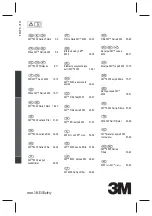
9
Membrane Replacement
This reverse osmosis system contains a replaceable component (the
RO membrane) which is critical to the efficiency of the system.
Replacement of this reverse osmosis membrane should be with one
of identical specifications as defined by Watts to assure the same
efficiency and contaminant reduction performance.
Membranes have a life expectancy between 2 and 5 years, de-
pending on the incoming water conditions and the amount the
RO system is used . This reverse osmosis membrane is critical for
effective reduction of total dissolved solids (TDS) . The product water
should be tested periodically to verify that the system is performing
satisfactorily .
Normally, a membrane would be replaced during a semiannual or
annual filter change . However, if at any time you notice a reduction
in water production or an unpleasant taste in the reverse osmosis
water, it could be time to replace the membrane . Watts recommends
replacing the membrane when TDS reduction falls below 75% .
Note: A water sample may be sent to Watts for a free diagno-
sis of your membrane performance. To send a water sample,
use two (2) clean containers and fill ½ cup of tap water in one
container and ½ cup of reverse osmosis water in 2nd container.
Clearly label each sample. Send the samples to the address
listed on the cover of this manual attention “Water Samples”.
Watts will test the water and mail or call you with the results.
Refer to Page 8 Annual Maintenance
Step A –
To change your membrane, follow the instructions for the
Annual Maintenance (previous section) . The procedure to
remove and change the membrane cartridge is the same
as all the other filter cartridges on the RO module .
Step B –
Check over the next 24 hours to ensure no leaks are pres-
ent .
Arsenic Facts
Arsenic (As) is a naturally occurring contaminant found in many
ground waters . Arsenic in water has no color, taste or odor . It must
be measured by an arsenic test kit or lab test .
Public water utilities must have their water tested for arsenic . You
can obtain the results from your water utility contained with in your
consumer confidence report . If you have your own well, you will need
to have the water evaluated . The local health department or the state
environmental health agency can provide a list of test kits or certified
labs .
There are two forms of arsenic: pentavalent arsenic (also called As
(V), As (+5)) and trivalent arsenic (also called As (III), As (+3)) . In well
water, arsenic may be pentavalent, trivalent, or a combination of
both . Although both forms of arsenic are potentially hazardous to
your health, trivalent arsenic is considered more harmful than pen-
tavalent arsenic .
RO systems are very effective at removing pentavalent arsenic . A free
chlorine residual will rapidly convert trivalent arsenic to pentavalent
arsenic . Other water treatment chemicals such as ozone and potas-
sium permanganate will also change trivalent arsenic to pentavalent
arsenic . A combined chlorine residual (also called chloramine) where
it does convert trivalent arsenic to pentavalent arsenic, may not con-
vert all the trivalent arsenic in to pentavalent arsenic . If you get your
water from a public water utility, contact the utility to find out if free
chlorine or combined chlorine is used in the water system .
This Watts reverse osmosis system is designed to remove up to 98%
of pentavalent arsenic . It will not convert trivalent arsenic to pen-
tavalent arsenic . Under laboratory standard testing conditions, this
system reduced 0 .30 mg/L (ppm) pentavalent arsenic to under 0 .010
mg/L (ppm) (the USEPA standard for drinking water). Actual perfor-
mance of the system may vary depending on specific water quality
conditions at the consumer’s installation . In addition to the indepen-
dent laboratory standard testing conditions Watts has conducted
additional field testing on our reverse osmosis units to determine
trivalent arsenic reduction capabilities . Based upon Watts field test-
ing, it has been determined that the RO units are capable of reducing
up to 67% of trivalent arsenic from the drinking water .
The RO membrane component of this Watts reverse osmosis system
must be maintained according to its recommended maintenance
cycle . Specific component identification and ordering information can
be found in the installation/operation manual maintenance section,
by phone at 1-800-224-1299 or online www .watts .com






























